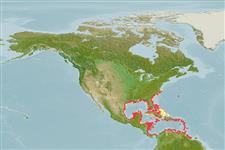>
Gobiiformes (Gobies) >
Gobiidae (Gobies) > Gobionellinae
Etymology: Evorthodus: Greek, eu = good + Greek, ortho = right + Greek, odous = teeth (Ref. 45335).
More on author: Girard.
Environment: milieu / climate zone / depth range / distribution range
Écologie
marin; eau douce; saumâtre démersal; amphidrome (Ref. 46888). Subtropical; 20°C - 30°C (Ref. 2059); 40°N - 7°N
Western Atlantic: Chesapeake Bay, USA and northern Gulf of Mexico to northern South America; absent in the Bahamas, but present in Greater Antilles.
Taille / Poids / Âge
Maturity: Lm ? range ? - ? cm
Max length : 15.0 cm TL mâle / non sexé; (Ref. 26340)
Épines dorsales (Total) : 6; Rayons mous dorsaux (Total) : 11; Épines anales: 0; Rayons mous anaux: 12. Caudal fin large and bluntly pointed with dark lyre-shaped mark on base consisting of 2 dark spots separated by pale central area. Snout very short, mouth small and inferior. Adults have first 3 or 4 dorsal fin spines elongate, reaching from third to sixth ray of second dorsal in females, to base of caudal peduncle in males. Predorsal area and top of head scaled as far forward as eye (Ref. 26938).
Occur mainly in muddy backwaters of bays and estuaries, often in foul waters. Also found on muddy bottoms of fresh water (Ref. 13628).
Life cycle and mating behavior
Maturité | Reproduction | Frai | Œufs | Fécondité | Larves
Benthic spawner.
Robins, C.R. and G.C. Ray, 1986. A field guide to Atlantic coast fishes of North America. Houghton Mifflin Company, Boston, U.S.A. 354 p. (Ref. 7251)
Statut dans la liste rouge de l'IUCN (Ref. 130435: Version 2024-1)
Menace pour l'homme
Harmless
Utilisations par l'homme
Outils
Articles particuliers
Télécharger en XML
Sources Internet
Estimates based on models
Preferred temperature (Ref.
123201): 23.5 - 28.2, mean 27.1 °C (based on 636 cells).
Phylogenetic diversity index (Ref.
82804): PD
50 = 0.7500 [Uniqueness, from 0.5 = low to 2.0 = high].
Bayesian length-weight: a=0.00977 (0.00444 - 0.02153), b=3.04 (2.85 - 3.23), in cm total length, based on LWR estimates for this (Sub)family-body shape (Ref.
93245).
Niveau trophique (Ref.
69278): 3.5 ±0.5 se; based on size and trophs of closest relatives
Résilience (Ref.
120179): Haut, temps minimum de doublement de population inférieur à 15 mois (Preliminary K or Fecundity.).
Fishing Vulnerability (Ref.
59153): Low vulnerability (10 of 100).
